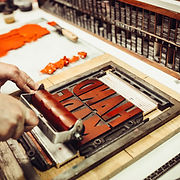Bindery & Finishing
Here are the bindery and finishing capabilities we offer:
- Saddle Stitching: This bindery method fastens folded papers along the fold by placing several staples along the center spine. Saddle stitching secures pages in booklets, pamphlets, notebooks, calendars, and other printed materials.
- Perfect Binding: A fast-drying glue is placed along the binding edge of a magazine or book and then attached to the cover using a flexible adhesive. The bindery process holds the pages together, creating a squared-off finished product.
- Die Cutting: A metal die cuts through printed paper or other material, forming delicate shapes that are unachievable using a guillotine cutter or web press straight cutter.
- 3-Hole Drilling: A rotating paper drill creates three holes along the edge of a paper stack.
- Embossing/Debossing: In embossing, applying a die with pressure to the back of a substrate or paper will imprint an image, permanently altering the surface and creating a raised or three-dimensional appearance. Debossing impacts the front of the paper stock, achieving a sunken appearance of the image.
- Folding: Bending printed pieces of paper using a right angle or parallel fold forms pamphlets, brochures, or booklets.
- Shrink Wrapping: Shrink-wrapping is a secure, quick, and inexpensive wrapping method. A plastic polymer film gets placed over a product. Heat is applied, shrinking the film around the item. Typical applications include wrapping books, DVDs, and other printed materials for protective or grouping purposes.
- Gluing (hot met/cold/fugitive): Hot or cold glue gets applied on product labels without an adhesive layer. Fugitive glue provides a strong yet easily openable seal and is effective in mailers and multiple-part forms that require separating.
- Inserting: Printed material gets inserted into other printed pieces and is generally smaller than the original piece.
- Padding: A padding compound applied along one side of a paper stack joins individual forms or sheets together. A chipboard backer on the back of the pad adds stability.
- Perforating: A metal die makes a series of cuts to enable easy detachment of a specific portion of a paper sheet. Cuts are possible vertically, horizontally, or both.
- Scoring: Scoring applies a straight crease to paper or cardboard, facilitating easy and accurate folding.
